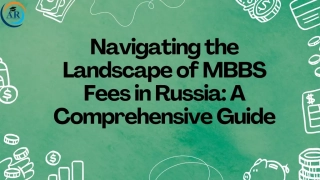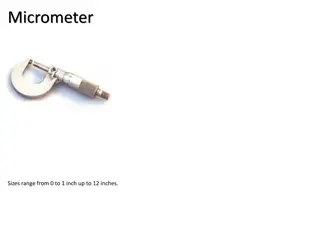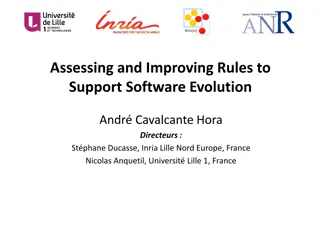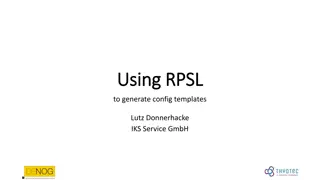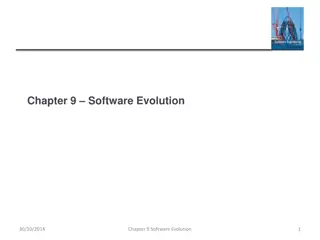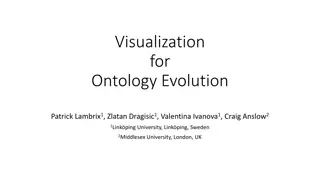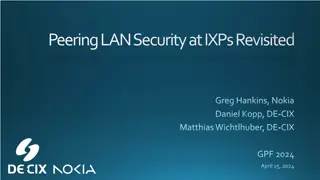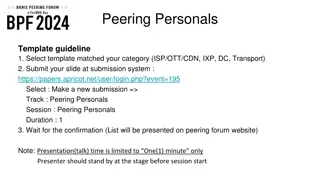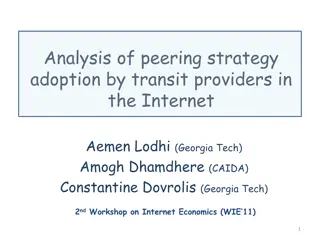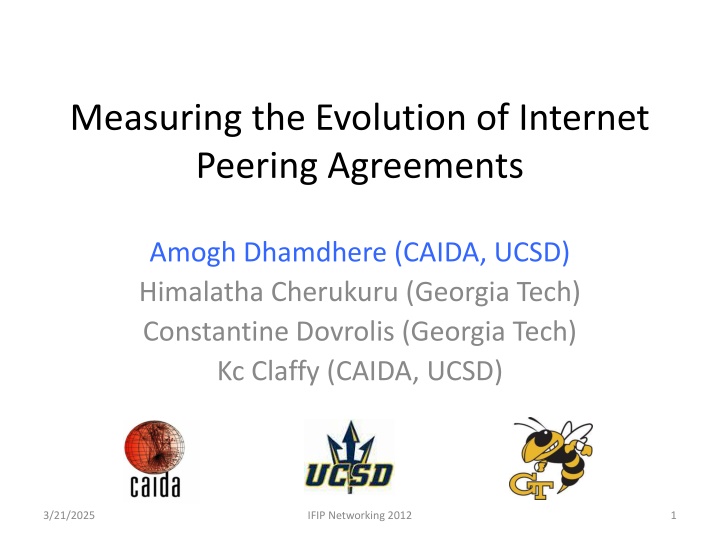
Evolution of Internet Peering Agreements: A Comprehensive Study
Explore the evolution of internet peering agreements among autonomous systems through the study of interdomain topology, traffic flow, and economics. Learn about the methods used to analyze usable route monitors and classify AS links for a more complete understanding of peering dynamics.
Uploaded on | 0 Views
Download Presentation

Please find below an Image/Link to download the presentation.
The content on the website is provided AS IS for your information and personal use only. It may not be sold, licensed, or shared on other websites without obtaining consent from the author. If you encounter any issues during the download, it is possible that the publisher has removed the file from their server.
You are allowed to download the files provided on this website for personal or commercial use, subject to the condition that they are used lawfully. All files are the property of their respective owners.
The content on the website is provided AS IS for your information and personal use only. It may not be sold, licensed, or shared on other websites without obtaining consent from the author.
E N D
Presentation Transcript
Measuring the Evolution of Internet Peering Agreements Amogh Dhamdhere (CAIDA, UCSD) Himalatha Cherukuru (Georgia Tech) Constantine Dovrolis (Georgia Tech) Kc Claffy (CAIDA, UCSD) 3/21/2025 IFIP Networking 2012 1
Background The Internet consists of ~40,000 independently operated and managed networks (Ases) Various types: transit, content, access, enterprise Distributed, decentralized interactions between ASes Transit: Customer pays provider Settlement-free peering: Exchange traffic for free 3/21/2025 IFIP Networking 2012 2
Topology, Traffic flow, and Economics Interdomain topology determines traffic flow Traffic flow determines the flow of money Much recent interest in interdomain traffic, topology, and economics Arbor networks, Sigcomm 10: Interdomain traffic consolidates, more traffic flows directly on peering links, bypassing tier-1 transit providers How do interdomain peering agreements evolve over time? 3/21/2025 IFIP Networking 2012 3
Previous Work BGP data from Routeviews/RIPE Interdomain topology maps Interdomain topology snapshots constructed from this data are incomplete! Most transit links are visible Settlement-free peering links are not visible Previous work has focused on measuring the evolution of transit links 3/21/2025 IFIP Networking 2012 4
Our Approach Instead of studying the partial connectivity of all ASes, we study the (near) complete connectivity of a subset of ASes Use BGP route monitors ASes that provide BGP feeds to Routeviews/RIPE Identify usable route monitors ASes for which nearly their complete connectivity is visible Classify the AS links of these usable route monitors 3/21/2025 IFIP Networking 2012 5
Usable Route Monitors L3 L2 L1 BGP route monitors: ASes that provide BGP feeds to Routeviews/RIPE collectors Usable Route Monitors: ASes for which more connectivity is visible from the local monitor than from remote monitors 3/21/2025 P1 R1 RV M R2 C1 C2 Remote view: C1, C2, P1 Local view: C1, C2 M is not usable IFIP Networking 2012 6
Usable Route Monitors L3 L2 L1 BGP route monitors: ASes that provide BGP feeds to Routeviews/RIPE collectors Usable Route Monitors: ASes for which more connectivity is visible from the local monitor than from remote monitors 3/21/2025 P1 R1 RV M R2 C1 C2 Remote view: C1, C2, P1 Local view: C1, C2, R1, R2, P1 M is a usable monitor IFIP Networking 2012 7
Usable Route Monitors Our BGP topology snapshots span 12 years from 1998-2010 Snapshots collected every 3 months, each snapshot collected over 3 weeks Identified usable route monitors in each snapshot A set of 56 route monitors were usable between 2006-2010 Business type distribution using peeringDB: 11 Large Transit Providers , 14 Regional Transit Providers , 12 Content Consumers, 6 Content Providers, 2 Entrerprise Networks, 11 Education/research networks 3/21/2025 IFIP Networking 2012 8
Classifying links of Usable Route Monitors Two step process to classify the links of usable route monitors Step 1: Classify a link as transit or non-transit Based on the visibility of a link from remote monitors Step 2: Classify a transit link as customer- provider or provider-customer Based on the AS path seen by remote monitors 3/21/2025 IFIP Networking 2012 9
Transit vs. Non-transit Links Peering link M-R is visible if the route monitor is lower in the hierarchy than M Choose route monitors likely to be higher in the hierarchy than M Use AS degree M-P1 is visible from most large remote monitors transit link If M-R1 and M-R2 are not visible from most large remote monitors non- transit links Also includes backup and one-direction transit links RV 3 RV2 RV1 P1 R2 M R1 RV4 3/21/2025 IFIP Networking 2012 10
Customer vs. Provider links Monitors higher than M see the form ..X M.. for a provider X of M Choose route monitors likely to be higher in the hierarchy than M If most large remote monitors observe the form X-M X is a provider of M Else, if most large remote monitors observe the form M-X X is a customer of M RV1 RV2 RV3 X M RV4 RV1, RV2, RV3: path form X M RV4: path form M X 3/21/2025 IFIP Networking 2012 11
Validating the classification algorithm Ground truth from 6 networks: 3 provided us full routing tables, 3 are usable monitors at Routeviews/RIPE Classification accuracy of 90%. GAO had accuracy of 80% on same data We classify several links of tier-1 networks as non-transit On digging deeper, we find a significant number of these are prepended Backup, or uni-directional transit 3/21/2025 IFIP Networking 2012 12
Application: Link Dynamics We apply the link classification algorithm to each usable route monitor for each topology snapshot Obtain a time series of link relationships between each monitor M and each neighbor N State is one of NONE , Non-Transit , Customer , Provider (M,N): NONE, NONE, NT, NT, NT, C, C, C, C For each monitor type and each link type, measure link durations and link state transition probabilities 3/21/2025 IFIP Networking 2012 13
Link Durations Provider links of LTP monitors have the shortest duration Non-transit links of LTPs have the shortest duration, while those of STPs, CPs, and CCs are longest Due to customer of LTP changing from backup to full transit CDF CDF 0.1 0.2 0.3 0.4 0.5 0.6 0.7 0.8 0.9 0.1 0.2 0.3 0.4 0.5 0.6 0.7 0.8 0.9 1 1 0 0 5 5 10 10 non-transit link duration (months) 15 15 provider link duration (months) 20 20 25 25 30 30 35 35 40 40 STP STP LTP LTP CC CC CP ER CP ER EC 45 45 50 50 55 55 3/21/2025 IFIP Networking 2012 14
State Transition Diagrams 0.94 0.94 0.66 0.18 cust cust 0.11 0.12 0.03 0.04 0.02 0.04 0.90 0.96 none 0.23 none 0.70 0.02 non-transit 0.03 non-transit 0.79 0.93 0.17 0.04 prov prov 0.07 0.04 LTP STP Links to STPs initially appear as non-transit. Links to LTPs mostly appear as transit Transition diagrams useful to study macroscopic evolution 3/21/2025 IFIP Networking 2012 15
Conclusions/Future Work Studied the complete connectivity of a few ASes usable BGP route monitors Small steps towards better AS relationship inference CAIDA s AS-rank: AS relationship classification algorithm, seeking validation from operational community: as-rank.caida.org Incorporate the heuristics presented here into AS-rank Top-down model of interdomain topology evolution using link state transition probabilities 3/21/2025 IFIP Networking 2012 16
Thanks! Questions? Contact me (amogh@caida.org) for comments, questions, datasets etc. 3/21/2025 IFIP Networking 2012 17

